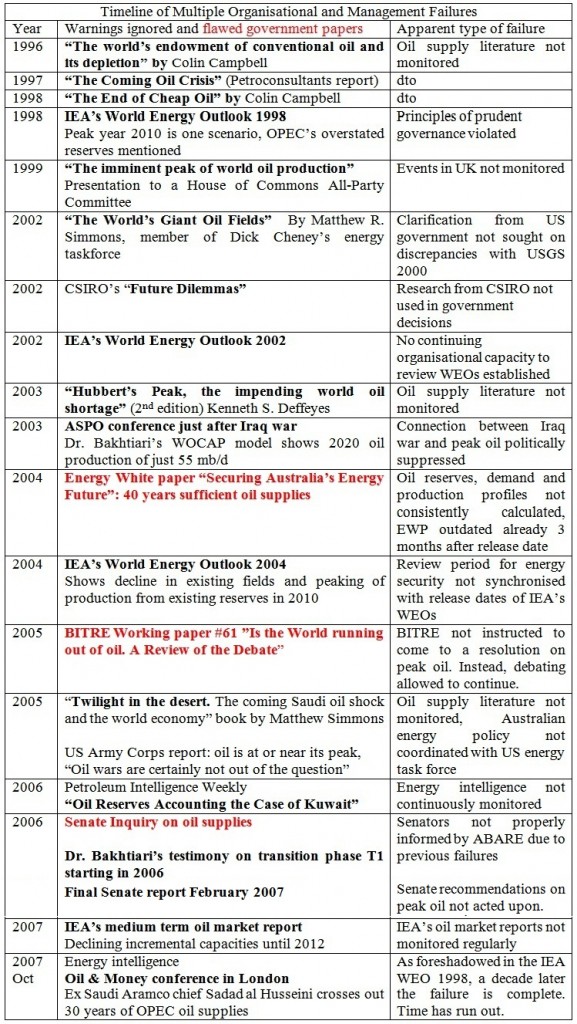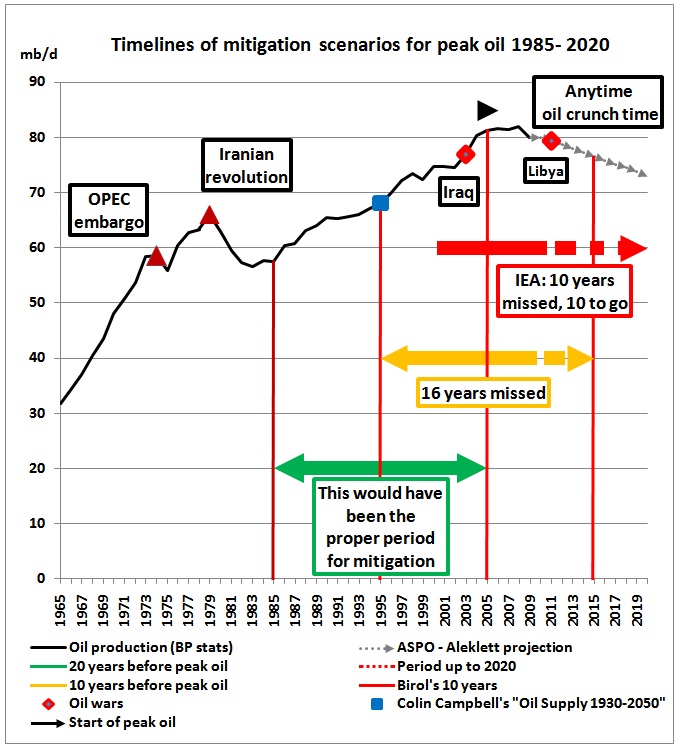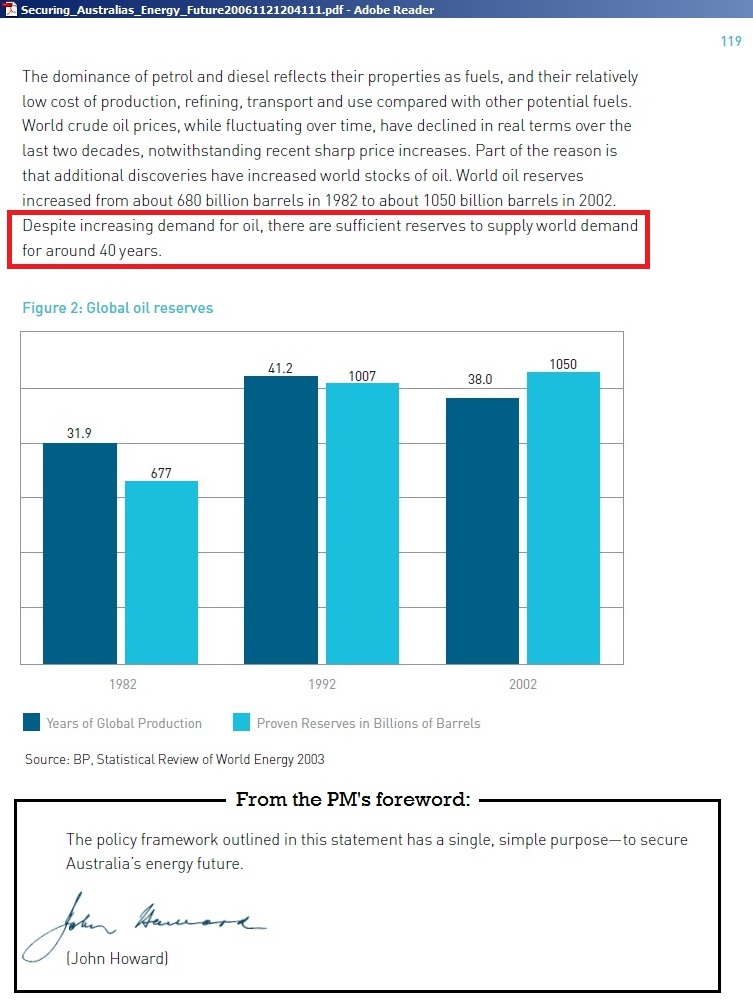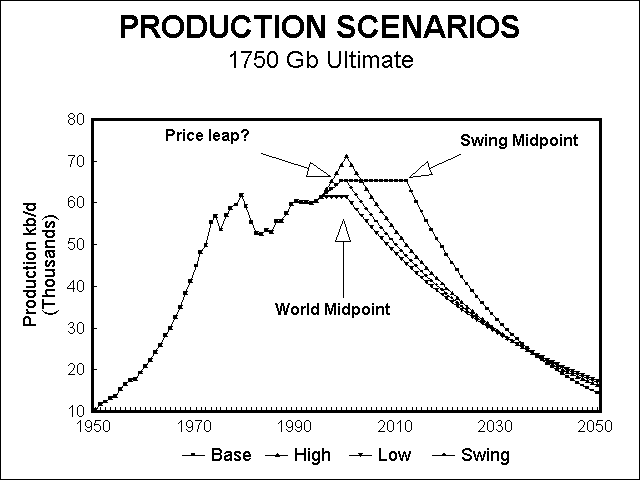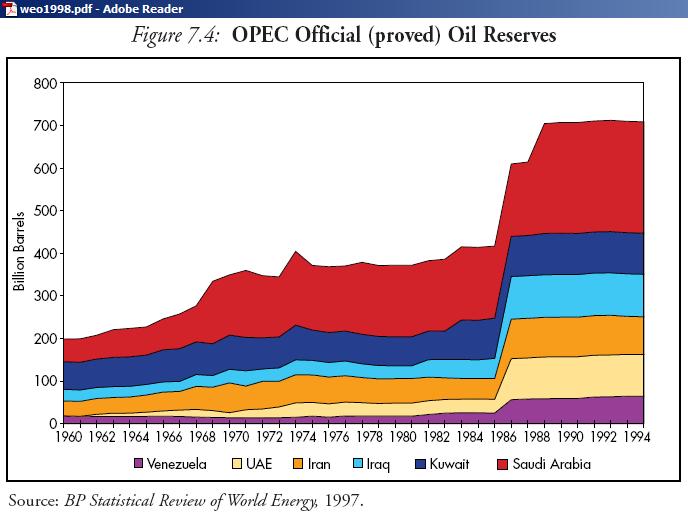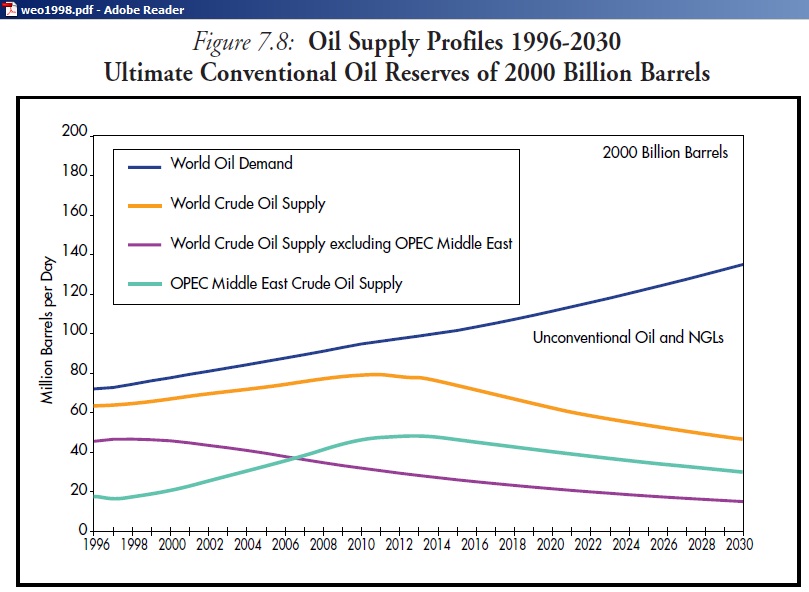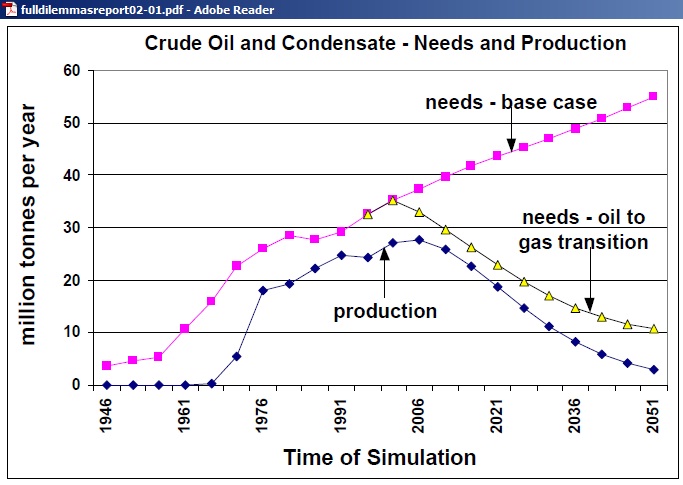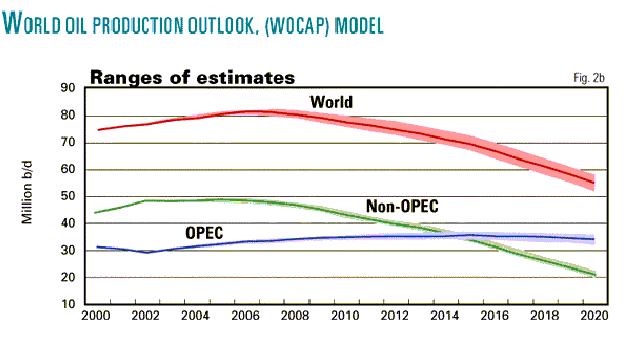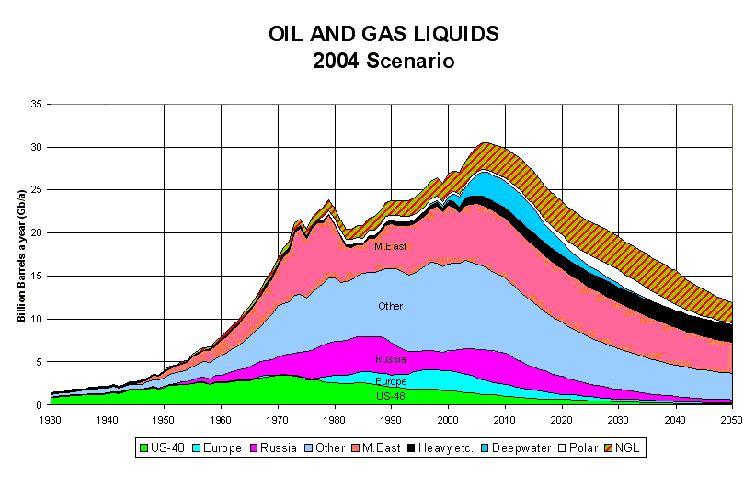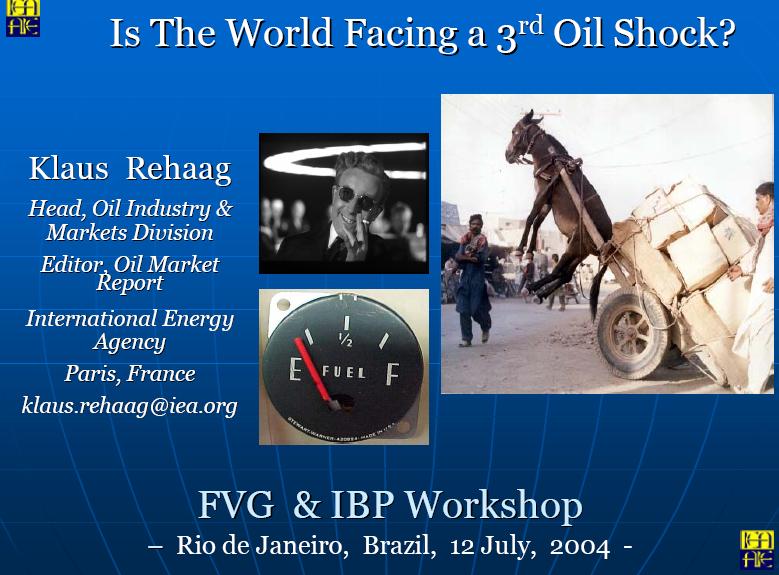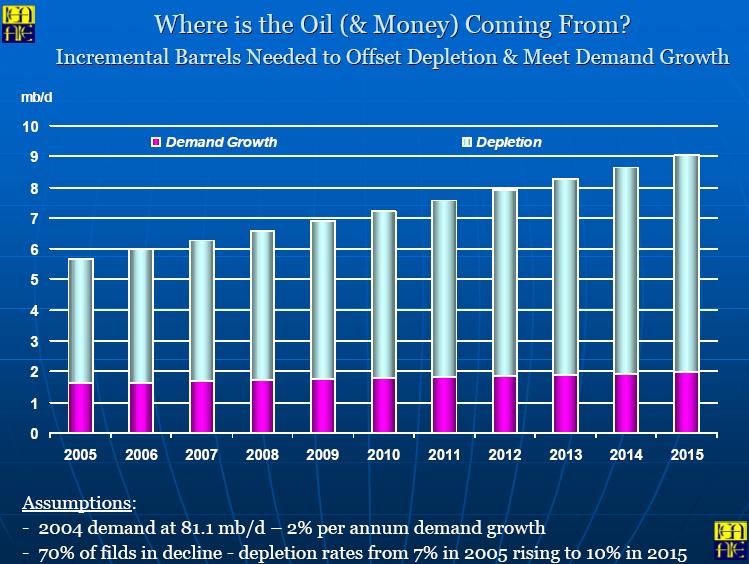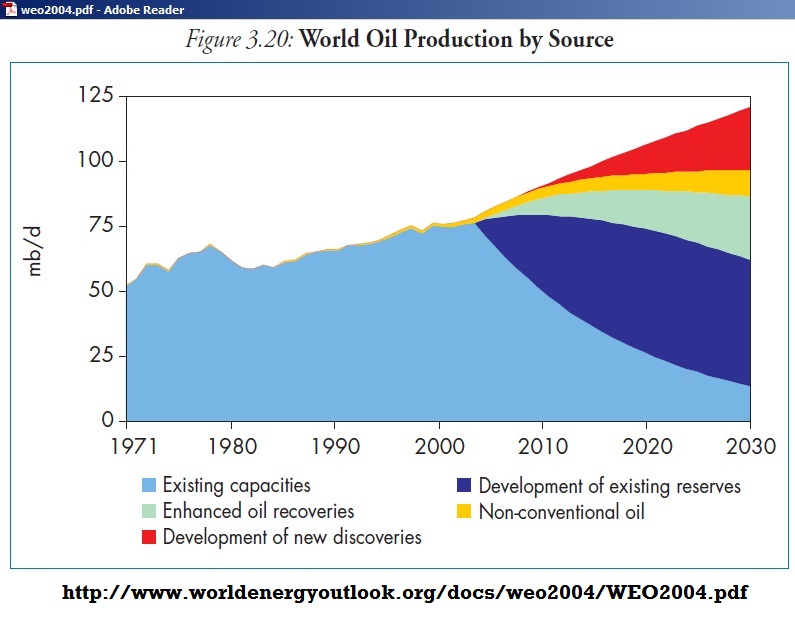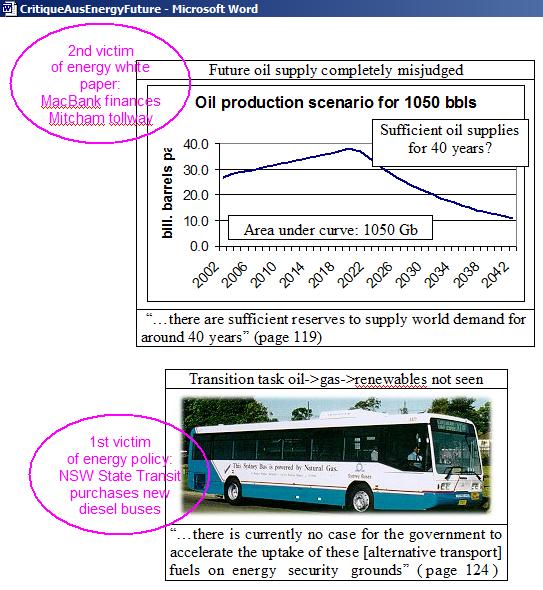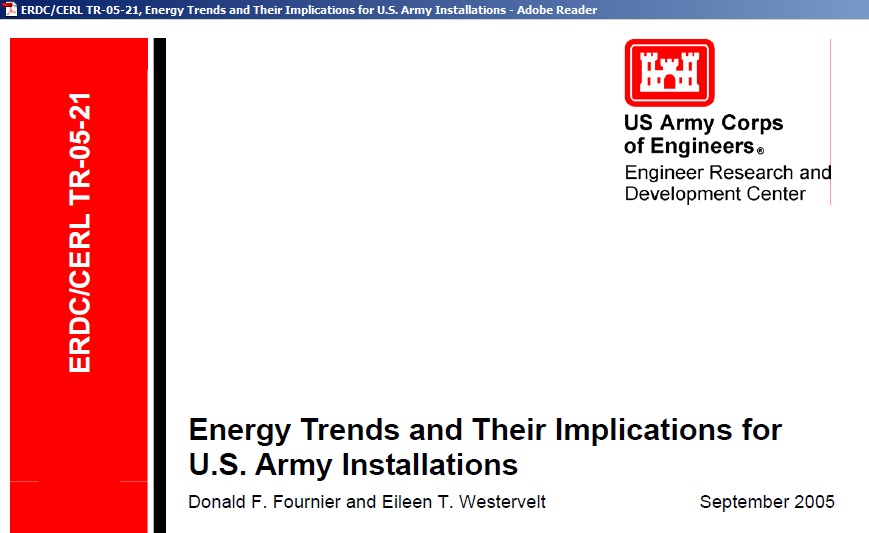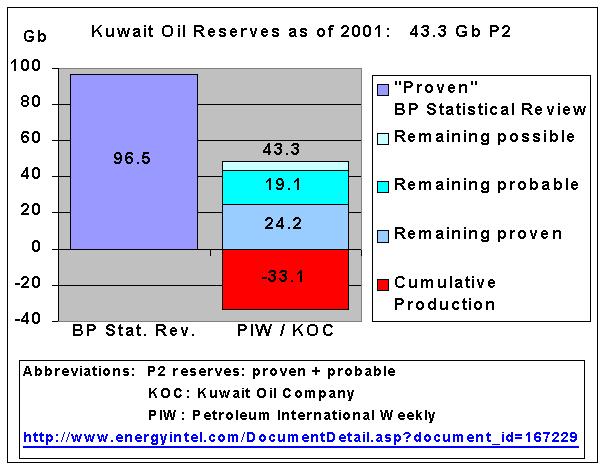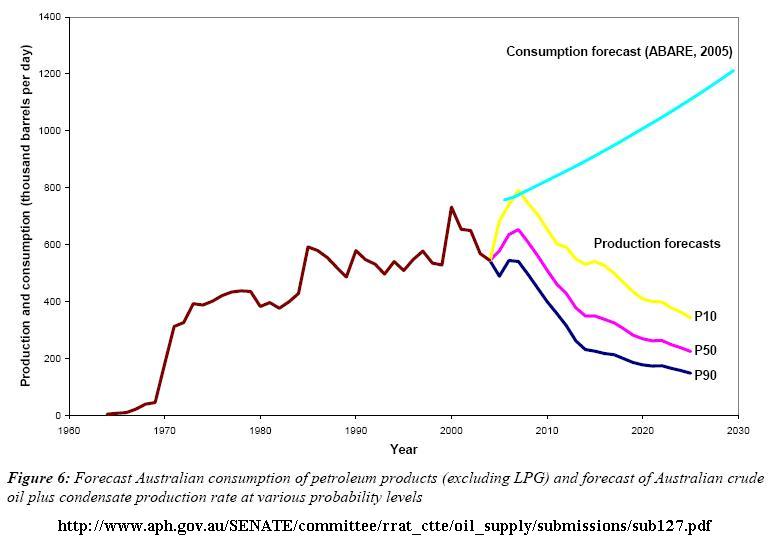Only weeks after the IEA conceded that crude oil peaked in 2006 we have another indicator for the peaking: The IEA was forced to release oil from the Strategic Reserve because Saudi Arabia could not increase production to compensate for lost Libyan oil production. Saudi Aramco statistics show that their crude oil exports peaked between 2005 and 2008.
Quite obviously, the world has lost one degree of freedom, namely to quickly increase oil production whenever something happens somewhere in the world which impacts – either directly or indirectly – on global oil supplies. This has created an inherently instable situation which is the cause for many problems we see on TV every day.
Therefore, it is now high time to describe how peak oil could have happened without the government of the day having been able to foresee this turning point in history, not to mention having failed to take precautionary action which would have been necessary at least 10 years before the peak (Hirsch report 2005).
This is important because the present bureaucracy and the current decision makers do not seem to have understood the historic context, the seriousness of what is happening and the timelines needed to adapt to declining oil production. Essentially, they still continue business as usual and think there is a technological fix in the wings while we face a primary energy crisis of the 1st order because not only oil but also coal has to be replaced. In the not too distant future the public will finally realize what peak oil means and turn their attention to who is responsible for their plight.
International readers might find the situation in their country of residence quite similar.
Q&A Shoe-thrower video here: http://www.bbc.co.uk/news/world-asia-pacific-11624692
Original Bush shoe thrower video here: http://www.youtube.com/watch?v=VxDQBkhqrQU
Iraq war in 2003, the 1st peak oil war
This analysis shows that the Howard government which came to power in 1996 should have detected the problem in 1999 at the latest. Its peak oil denial mode continued until the very end in 2007 despite an increasing number of warnings. There can be no doubt that one day this failure will enter history books, on the wrong side of the ledger, as a serious violation of the principles of prudent governance.
Without analysis what went wrong no remedial action can be taken to address the current situation. The public is generally not yet aware that the problem is quite advanced, that the time lost cannot be recouped and that therefore we need to go into emergency mode now. Immediate, fundamental changes will have to take place in government departments, parliaments, financing institutions, universities and schools, the media and last not least the electorate.
Consequences of Howard’s failures:
(1) 8 years under the Howard government have been irreplaceably lost
(2) A whole generation of staff in energy and transport related departments in both State and Federal governments remained basically un-trained on peak oil and energy related matters
(3) A new generation of young, aspiring people has chosen jobs for which there will be less demand in future
(4) People have bought cars for which there will not be enough petrol and they have settled in suburbs for which there will be no proper public transport
(5) Billions of dollars of public money were wasted on oil dependent infrastructure
(6) This infrastructure created unsustainable city structures (spatial distribution and patterns of various land uses) which will be impossible to rectify in a period of declining oil production
(7) Contributions to super annuation funds – an industry given a boost by the previous Hawke-Keating government and which invested in oil dependent infrastructure – have been put unnecessarily at risk
(8) The unique chance to use the budget surplus before peak oil for projects to mitigate peak oil has been irremediably missed
(9) The Australian gas industry has been locked into long-term export contracts which will be bitterly regretted when gas is urgently needed both as transport fuel, for power generation and fertilizer production
(10) Consultants and contractors have been left untrained and unprepared to implement massive rail projects which will be necessary to replace energy-inefficient road and air-traffic
(11) Many solutions for peak oil like VFTs and rail tunnels in urban areas are now out of reach because they are either no longer affordable or cannot be implemented in time
(12) The public has been lulled into believing Australia is an energy superpower while it will be plunged into an oil import crisis
The following graph shows the timelines involved:
Scenario with current mind set and policies
(1) OK, we had peak oil, so what. Decades of oil supplies are left.
(2) Assumption: now we need other cars (more fuel efficient, electric), and other fuels (Ethanol, LPG, NG). Technology will advance fast and lower cost.
(3) Therefore, we can continue with highways, toll-ways, road tunnels etc.
(4) Expensive rail tunnel projects are started in urban areas
(5) The oil crunch arrives at filling stations (quite likely before 2015 depending on how fast MENA countries disintegrate). Desperate attempts will be made to quick-fix the problem
(6) The general energy problem becomes apparent as nasty climate change events force us to replace our coal fired power plants much earlier than generally assumed
(7) Society experiences the end of our free-wheeling car culture, especially the long-distance commuting
(8) By 2020 we have a different world with declining globalisation.
(9) Governments scramble to invest in public transport but a budget crisis and diesel shortages delay all projects which damage the economy more than would otherwise have been the case
Alternative scenario:
(1) Stop business as usual, no more highway duplications, only black spot projects
(2) Educate motorists on car pooling
(3) Rescue toll-way operators (and super-funds) by developing a new business model (electric rail on free-way corridors)
(4) Rail duplication and electrification on main rail lines between capital cities
(5) Conversion of trucks and locomotives to CNG/LNG
(6) Night trains to replace domestic flights along the East coast
(7) Focus on securing agricultural production and transport of food to the cities
The alternative scenario does not guarantee that disruptions to the economy are avoided because the above program should have been started at least 10 years ago. But at least any further loss of time and money is avoided.
(A) Howard’s energy white paper
In June 2004, the Howard government published its Energy White Paper “Securing Australia’s Energy Future” (now archived in the National Library of Australia). It contained one remarkable sentence, a semantic twister by all standards: “Despite increasing demand for oil, there are sufficient reserves to supply world demand for around 40 years”. For those who don’t believe it, here is an excerpt from page 119, along with Howard’s signature in the foreword:
http://trove.nla.gov.au/work/17241630?selectedversion=NBD26118005
(B) The years before Howard’s energy white paper
How did the Howard government, which came to power in March 1996, arrive at this flawed statement, after 8 years in office? It missed, ignored or disregarded many warnings some of which are listed here (specific failures marked in red):
(1) January 1996 “The world’s endowment of conventional oil and its depletion”
from Irish oil geologist Colin Campbell http://www.hubbertpeak.com/campbell/
http://www.hubbertpeak.com/campbell/camfutur.htm
(2) 1997 “The Coming Oil Crisis” (Petroconsultants report)
http://www.hubbertpeak.com/library/cccrisis.htm
(3) March 1998 “The End of Cheap Oil”
Article in the Scientific American, by Colin Campbell
http://www.hubbertpeak.com/sciam983.htm
(4) November 1998
IEA’s World Energy Outlook 1998
http://www.iea.org/weo/docs/weo1998.pdf
Australia is a member of the IEA and this should have been known to the government:
“Experience in mature oil regions indicates that production builds to a peak when approximately half of the ultimately recoverable reserves has been produced, and then falls away. The application of new technologies, such as horizontal drilling and three-dimensional (3D) seismic analysis, determines the ultimate size of recoverable reserves. Technology can extend the peak and delay or slow the decline in production. But eventually production falls, given a fixed oil resource. This has been the experience, for example, in the United States.” (p 44)
“Total OPEC official oil reserves increased by almost 300 billion barrels between 1985 and 1989. Following the fall in the oil price in 1986, OPEC’s oil production quotas became an important issue to its member governments. Since reserves were an important potential factor in determining quota allocations, every OPEC country had an incentive to increase its published reserve estimate. In the space of just four years, total OPEC oil reserves increased by 62%. Since then, OPEC’s total oil reserves have remained virtually unchanged year after year.” (p 93)
The WEO 1998 came up with a range of conventional oil reserves and peak years:
2,000 Gb peak year 2010 at 79 mb/d (Fig 7.8, page 103)
2,300 Gb peak year 2014 at 79 mb/d (Fig 3.9, page 49)
3,000 Gb peak year 2020 at 95 mb/d (Fig 7.9, page 104)
This graph shows a huge gap developing between crude oil production and oil demand which is filled by unconventional oil and NGLs (natural gas liquids). In table 7.18 calculations show that a whopping 19.1 mb/d are assumed to come from “Unidentified Unconventional Oil” by 2020.
What is important here is that the principles of prudent governance would have demanded to assume the lower reserve estimate with a peak year in 2010, especially as the problem with OPEC’s reserves was mentioned. Moreover, the government should have asked the IEA about where exactly the unidentified unconventional oil was supposed to come from. That was absolutely crucial because the 2020 demand of 111.5 mb/d was covered by only 92.4 mb/d of estimated conventional supply.
(5) 1999 “The imminent peak of world oil production”
Presentation to a House of Commons All-Party Committee
http://www.hubbertpeak.com/campbell/commons.htm
Australia has a special relationship to the UK, so Canberra should have monitored what is going on there.
Therefore, items (4) and (5) together represent the point where the Howard government should have taken action.
(6) 2002 “The World’s Giant Oil Fields” By Matthew R. Simmons
“This study of giant oilfields does not focus on proven reserves. Instead, it focuses on what these fields now produce each day….
What I found, after extensive digging, is that a small percent of the world’s oilfields comprise a surprisingly large percent of current daily supply. Almost all of the biggest giant oilfields are old. Many are very old. The new giants found over the past 50 years have been progressively smaller over time, particularly in terms of peak production rates.”
http://hubbert.mines.edu/news/Simmons_02-1.pdf
Matthew Simmons was member in Dick Cheney’s energy task force. This is what he said in his speech in 1999 at the Institute of Petroleum:
“While many regions of the world offer great oil opportunities, the Middle East with two thirds of the world’s oil and the lowest cost, is still where the prize ultimately lies, even though companies are anxious for greater access there, progress continues to be slow…
Oil is unique in that it is so strategic in nature. We are not talking about soapflakes or leisurewear here. Energy is truly fundamental to the world’s economy. The Gulf War was a reflection of that reality”
http://www.energybulletin.net/node/559
(7) 2002 CSIRO Future Dilemmas
The CSIRO warns that domestic oil production will peak in 2006 with a probability of 50% (Fig 4.1, p 119) and that “world production from traditional supplies will soon peak” (p 170). Therefore, in order to reduce net oil imports to a minimum, an oil to gas transition should reach 50% by 2020 (Fig. 5.10, p 171)
Fig 5.10 showing that oil needs (and therefore oil imports) are
dramatically reduced by an oil to gas transition
http://www.cse.csiro.au/research/futuredilemmas/
(8) November 2002 IEA’s World Energy Outlook 2002
This is important to mention here because the WEO 2002 oil production estimate of 104 mb/d in 2020 was later quoted in Howard’s energy white paper (p. 120). 4 years after its WEO 1998 the IEA dropped all references to peak oil without anything happening in oil fields which would have dramatically changed the previous outlook.
“The oil supply projections in this Outlook are derived from aggregated projections of regional oil demand, as well as projections of production of conventional oil in non-OPEC countries and nonconventional oil worldwide. OPEC conventional oil production is assumed to fill the gap.” (p. 95)
http://www.worldenergyoutlook.org/docs/weo2002_part1.pdf
This assumption was not mentioned later in Howard’s energy white paper, a fatal omission.
(9) December 2002
Managing director and CEO of Woodside Petroleum John Akehurst shows graphs with a peak of Australian oil production already in the year 2000.
http://www.aspo-australia.org.au/introduction/oil-production-decline.html
(10) March 2003 “Hubbert’s Peak, the impending world oil shortage” (2nd edition)
Kenneth S. Deffeyes
“The mathematical peak falls at the year 2004.7; call it 2005. However, I’m not betting the farm that the actual year is 2005 and not 2003 or 2006. The top of the mathematical distribution is smoothly curved, and there is a fair amount of jitter in the year-to-year production…There is nothing plausible that could postpone the peak until 2009. Get used to it.”
http://www.princeton.edu/hubbert/
(11) May 2003 – April 2004
Dr. Bakhtiari, from the National Iranian Oil Company, shows his oil production estimate at the ASPO conference in Paris, using his “World Oil Production Capacity” (WOCAP) model with a peak in 2006 and a decline to 55 mb/d in 2020.
http://www.peakoil.net/conferences/iwood-2003-paris
http://www.peakoil.net/iwood2003/paper/BakhtiariPaper.doc
His work was published in the Oil & Gas Journal 26/4/2004, just 2 months before the release of Howard’s energy white paper
www.aspo-australia.org.au/References/Bakhtiari-O&GJ-April%202004.doc
(12) May 2004
The ASPO Newsletter May 2004 edited by Colin Campbell shows a peak of “regular oil” in 2005 and an all liquids peak in 2007
http://aspoireland.org/newsletter/newsletters-pdf/
http://www.hubbertpeak.com/nations/2004/images/GlobalScenario2004.jpg
June 2004: Energy White Paper
The above graph should have been included in Howard’s EWP
http://trove.nla.gov.au/work/17241630?selectedversion=NBD26118005
(13) July 2004
IEA workshop “Is the World Facing a 3rd Oil shock?”
Presentation by the editor of the Monthly Oil Market Report: 70% of fields in decline; depletion rates of 7% by 2005 increasing to 10% pa in 2015
http://www-personal.umich.edu/~twod/oil-ns/articles/research-oil/iea_3rd_oil_shock_kr_rio_2004.pdf
(14) November 2004
IEA’s World Energy Outlook 2004 came out – as usual – in November.
First, the problem with OPEC’s reserves was mentioned again:
“Total OPEC reserves jumped from 536 billion barrels in 1985 to 766 billion barrels in 1990. As a result, world oil reserves increased by more than 30%. This hike in OPEC countries’ estimates of their reserves was driven by negotiations at that time over production quotas, and had little to do with the actual discovery of new reserves. In fact, very little exploration activity was carried out in those countries at that time. Total reserves have hardly changed since the end of the 1980s.” (p92)
This should have alerted the authors of the EWP to the 1998 assumption that OPEC would always fill the gap between demand and Non-OPEC supply (see item 8 above)
Second, for the 1st time in the history of the WEOs, a graph showed the decline in existing oil fields.
Howard’s Energy White Paper was outdated already 3 months after it was published. With an election win in October 2004 his government started a fresh term with a flawed energy policy, without noticing or caring about it. The review period of 2 years (page 115, EWP) was out of sync with the WEO release dates of the International Energy Agency, an organisational failure of the 1st order.
(C) Howard’s response to Energy White Paper critique made things worse
When the Productivity Commission called for submissions on energy efficiency I submitted a critique of the energy white paper (submission 4) in November 2004 which is available here:
http://www.pc.gov.au/projects/inquiry/energy/docs/submissions
I pointed out that the above quoted statement about 40 years of sufficient oil supplies is logically inconsistent with the reserves shown in Fig 2.
http://www.pc.gov.au/__data/assets/pdf_file/0006/44763/sub004main.pdf
http://www.pc.gov.au/__data/assets/pdf_file/0004/84541/sub004appendices.pdf
If production increases along with demand to 104 mb/d in 2020 (EWP, page 120) then production must decline by 6% after 2020 to satisfy the 1050 Gb reserve condition, leaving a reasonable tail end production after 40 years.
The oil production figure for 2020 was copied from the IEA WEO 2002. The IEA in the meantime had no longer referred to the peaks in their WEO 1998. A short summary on IEA’s World Energy Outlooks up to November 2009 can be found here:
http://www.crudeoilpeak.com/downloads/Short_History_Of_IEA_World_Energy_Outlooks.pdf
Howard was re-elected in October 2004 and I forwarded the above documentation with a warning that peak oil might happen in his next term.
I received a reply in November 2004 with a letter attached from then Resource Minister Ian McFarlane saying that peak oil is between 2030 and 2075 and that I should consult the following website of the US Department of Energy (released in August 2004)
Long-Term World Oil Supply Scenarios
“Using the USGS mean (expected) resource base estimate (3003 Gb) and an annual production growth rate of 2% (similar to the current rate), the estimated peak production year is 2037”
http://www.eia.doe.gov/pub/oil_gas/petroleum/feature_articles/2004/worldoilsupply/oilsupply04.html
I found that the scenarios (conventional oil) quoted by McFarlane are what I call “geometric scenarios”. The peaking point is determined by intersecting 2 curves:
(a) An x % demand growth curve
(b) A declining production curve at the reserve to production ratio (R/P) of 10
The boundary condition for this graphical exercise at HSC year 12 level is that the area under the curves must equal the total reserves. Easy. But as we can have an unlimited number of x% to reserve combinations you can pick the peak that suits you.
http://www.eia.doe.gov/pub/oil_gas/petroleum/feature_articles/2004/worldoilsupply/figure3.jpg
Of course this graph has nothing to do with the reality of oil production. What’s worse, declines after the peak at R/P=10 are so steep that this is akin to a collapse in production. No economy could survive this. Therefore, if these were supposed to be serious calculations, the authors should have warned that such scenarios – if technically feasible at all – should be avoided by policy measures. Maybe they realized this and had therefore one scenario on offer with a 2% growth and a 2% decline rate, peaking in 2016.
http://www.eia.gov/pub/oil_gas/petroleum/presentations/2000/long_term_supply/sld014.htm
MacFarlane’s reference to the EIA scenarios in reply to my Energy White Paper critique had made things actually worse. Nowhere in the EWP was it claimed that oil production would go up to the dizzying heights of 50 Gb pa as in the EIA scenarios.
So when I saw the government was walking in the dark, I wrote another submission to the Productivity Commission in February 2005 (#75), titled “Lessons from EIA scenarios”
http://www.pc.gov.au/__data/assets/pdf_file/0004/45643/sub075attachment1.pdf
I sent a copy to Howard but never received a reply.
(15) February 2005
BITRE Working paper #61”Is the World running out of oil. A Review of the Debate”
http://www.bitre.gov.au/info.aspx?NodeId=16&ResourceId=96
Peak oil is of course not about running out of oil, nor is it a topic which lends itself to an endless debate. What should have been done, for example, is an analysis of the above mentioned graph in the WEO 2004 as is contained in my critique of BITRE’s paper:
http://www.infrastructure.gov.au/aviation/nap/files_green_paper/MUSHALIK_Matt-CritiqueBTRE_WP61.pdf
When I shortly encountered Ian MacFarlane at BP Solar in Homebush in June 2005 and asked him about my letter he replied: “I know when peak oil is” and quickly sped away out of the seminar room.
(D) Howard’s last 3 years of peak oil denial
For 3 long years I continued to send updated peak oil information to Howard whenever new studies came out. Some letters were answered, always in denial mode (“I agree to disagree”), up to the last month of his term. This is a short list of events in the years 2005-2007 with relevance to oil supplies and peak oil, additional information and analysis
2005
(16) February 2005
The Hirsch report on peak oil mitigation, commissioned by the US department of Energy, is published.
“The peaking of world oil production presents the U.S. and the world with an unprecedented risk management problem. As peaking is approached, liquid fuel prices
and price volatility will increase dramatically, and, without timely mitigation, the economic, social, and political costs will be unprecedented. Viable mitigation options exist on both the supply and demand sides, but to have substantial impact, they must be initiated more than a decade in advance of peaking.”
http://en.wikipedia.org/wiki/Hirsch_report
(17) April 2005
IEA Press Release: Saving Oil in a Hurry
Today the IEA has issued a new analysis of measures that governments can use to “save oil in a hurry”. There are many possible reasons why governments might want to save oil quickly; an obvious one is to cope with oil supply disruptions.
“Our study shows that a number of measures could provide substantial reductions in transport oil use quickly and cheaply – if countries are well-prepared and act aggressively during an emergency”, said Claude Mandil, the Executive Director of the International Energy Agency (IEA) at the launch of Saving Oil in a Hurry.
This book provides an assessment of the potential oil savings and implementation costs of rapid oil demand restraint measures for transport. This tool box of measures includes new approaches towards telecommuting, car-pooling, transit use and “ecodriving” (fuel efficient driving styles), among other measures.
If implemented by many IEA countries, certain combinations of measures could reduce world oil demand by a significant amount – on the order of a million barrels per day or more. Such actions could be used to complement supply-side measures (such as use of strategic oil stocks) to help countries cope with oil supply disruptions, and avoid physical shortages and associated price spikes.
http://www.iea.org/press/pressdetail.asp?PRESS_REL_ID=146
Again, all alarm bells should have been ringing in Howard’s department.
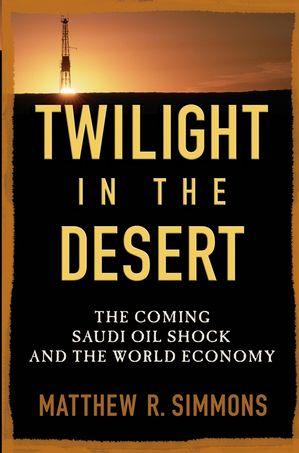 (18) Matthew Simmons published his book “Twilight in the desert. The coming Saudi oil shock and the world economy”
(18) Matthew Simmons published his book “Twilight in the desert. The coming Saudi oil shock and the world economy”
http://www.twilightinthedesert.com/
The Washington Post picked it up in August 2005:
Saudi Oil and the World Economy
http://www.washingtonpost.com/wp-dyn/content/discussion/2005/07/26/DI2005072601004.html
The shock happened in mid 2008 when Saudi Arabia could not pump enough oil to meet China’s extra demand for the Olympic Games. This caused the high oil prices and, converging with an underlying accumulated debt problem, triggered the GFC. This was later analysed by the Brookings Institute
Causes and Consequences of the Oil Shock 2007-2008
By James D. Hamilton
“Whereas historical oil price shocks were primarily caused by physical disruptions of supply, the price run-up of 2007-08 was caused by strong demand confronting stagnating world production.”
(19) September 2005
The US Army released a report on future oil supplies and its impact.
“World oil production is at or near its peak and current world demand exceeds the supply. Saudi Arabia is considered the bellwether nation for oil production and has not increased production since April 2003. After peak production, supply no longer meets demand, prices and competition increase” (xi)
General conclusions and implications
Throughout the 20th Century, the United States has been a profligate energy consumer. The rapid and expansive growth of the economy was based on cheap and abundant energy. Little thought and planning have been given to how to transition to the realities of the 21st Century when petroleum and natural gas resources will become depleted. The U.S. economy uses 50 percent more energy per unit of GDP than the other developed nations of the world (EIA 2004). The fossil fuel-based, automobile-centered, throw-away economy is not a viable model for the United States or the rest of the world over the long term. It is not sustainable. (page 53)
The oil market will remain fairly stable, but with steadily increasing prices as world production peaks. Demand now exceeds production and we are seeing that effect on prices. After the peak is reached, geopolitics and market economics will result in significant price increases above what we have seen to date. Security risks will also
rise. To guess where this is all going to take us is would be too speculative. Oil wars are certainly not out of the question. Any disruption of world oil markets may also affect world natural gas markets (page 53)
One thing is certain: it is going to be challenging and comprehensive approaches to energy issues are required. Uncertainty cannot be an excuse for inaction. Integrated resource planning is required and issues must be addressed from both the supply and demand viewpoint. The U.S. cannot drill its way to energy independence nor can we do it all with renewables and efficiency. A secure, reliable, and cost effective energy system must be robust, diverse, and aggressively incorporate renewables, energy efficiency, and intelligent use of fossil fuels. (page 55)
http://www.energybulletin.net/node/13737
http://stinet.dtic.mil/cgi-bin/GetTRDoc?AD=A440265&Location=U2&doc=GetTRDoc.pdf
On page 12, the report shows ASPO’s 2004 scenario of peaking oil production.
December 2005
But peak oil denial means more toll-ways. So nothing could deter Howard to miss this photo opportunity:
Howard opens M7 motorway
16/12/2005
The Prime Minister John Howard has officially opened Sydney’s latest toll road. The $1.5 billion Westlink M7 is 40 kilometres long, making it Australia’s largest urban road project.
http://www.abc.net.au/news/newsitems/200512/s1532487.htm
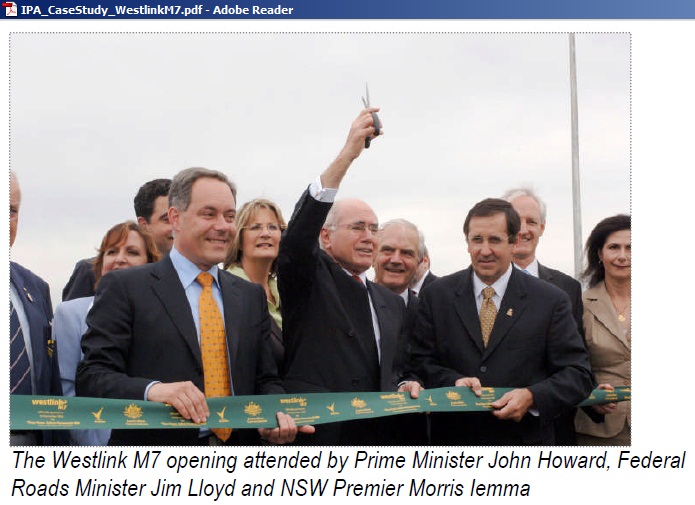 www.infrastructure.org.au/DisplayFile.aspx?FileID=19
www.infrastructure.org.au/DisplayFile.aspx?FileID=19
 http://img186.imageshack.us/img186/5622/m4m7interchange0441buj7.jpg
http://img186.imageshack.us/img186/5622/m4m7interchange0441buj7.jpg
Intersection M4-M7: off to a fossil fuel based, car centred future
The media were just repeating the numbers given to them:
18/11/2005
QUENTIN DEMPSTER:…. Traffic projections are 174,000 vehicles a day in the first year, rising to about 250,000 vehicles a day by 2016
http://www.abc.net.au/stateline/nsw/content/2005/s1510445.htm
But reality turned out to be different:
15/11/2010 Transurban’s M7 traffic 38% less than expected
http://crudeoilpeak.info/transurban%e2%80%99s-m7-traffic-38-less-than-expected
2006
(20) January 2006
Petroleum Intelligence Weekly
Oil Reserves Accounting: The Case Of Kuwait
The most striking statistic in the report is that as of March 2001, Kuwait’s remaining oil reserves stood at just 48 billion bbl. The total includes the whole of Kuwait plus its share of the Neutral Zone shared with Saudi Arabia, which is referred to in Kuwait as the Divided Zone (DZ). These barrels are split roughly 50-50 between “proven” reserves — those with a 90% certainty of being produced — and “nonproven,” which is assumed to be a combination of probable and potential. The total figure is more than 50% lower than Kuwait’s official proven reserves of 101.5 billion bbl, which are cited by Opec in its statistical bulletin for 2004. According to the US Energy Information Administration (EIA), Kuwait’s proven reserves have since been updated to 104 billion bbl, including the share of the DZ.
http://www.energyintel.com/documentdetail.asp?document_id=167229
(21) In 2006, the Senate did its own inquiry into oil supplies.
http://www.aph.gov.au/senate/committee/rrat_ctte/completed_inquiries/2004-07/oil_supply/index.htm
One of the most important submissions came from Geoscience Australia with a graph on declining Australian oil production:
 In July 2006, at a hearing in Sydney’s Parliament House (Jubilee room) Dr. Bakhtiari, retired from the Iranian National Oil Company, explained to the Senators: “The decline of global oil production seems now irreversible. It is bound to occur over a number of transitions, the first of which I have called transition 1, which has just begun in 2006. Transition 1 has a very benign gradient of decline, and it will take months before one notices it at all. But transition 2 will be far steeper, and each successive transition will show more pronounced declining gradients. My WOCAP model has predicted that over the next 14 years present global production of 81 million barrels per day will decrease by roughly 32 per cent, down to around 55 million barrels per day by the year 2020.”
In July 2006, at a hearing in Sydney’s Parliament House (Jubilee room) Dr. Bakhtiari, retired from the Iranian National Oil Company, explained to the Senators: “The decline of global oil production seems now irreversible. It is bound to occur over a number of transitions, the first of which I have called transition 1, which has just begun in 2006. Transition 1 has a very benign gradient of decline, and it will take months before one notices it at all. But transition 2 will be far steeper, and each successive transition will show more pronounced declining gradients. My WOCAP model has predicted that over the next 14 years present global production of 81 million barrels per day will decrease by roughly 32 per cent, down to around 55 million barrels per day by the year 2020.”
http://www.aph.gov.au/hansard/senate/commttee/S9515.pdf
The Senate delivered a final report in February 2007 with 10 recommendations. The first two were:
Recommendation 1
The committee recommends that Geoscience Australia and ABARE reassess both the official estimates of future oil supply and the ’early peak’ arguments and report to the Government on the probabilities and risks involved.
Recommendation 2
The committee recommends that in considering a less oil dependent policy
scenario, the Government take into account the concerns expressed in the World
Energy Outlook 2006, namely –
- current trends in energy consumption are neither secure nor sustainable;
- energy policy needs to be consistent with environmental goals, particularly the need to do more to reduce fossil fuel carbon dioxide emissions.
These 2 recommendations were never acted upon.
2007
(22) January 2007
Article in the New York Times
Iran actually is short of oil
“Iran has ensnared itself in a petroleum crisis that could drive its oil exports to zero by 2015. While Iran has the third- largest oil reserves in the world, its exports may be shrinking by 10 to 12 percent per year. How can this be happening?”
http://www.nytimes.com/2007/01/08/opinion/08iht-edstern.4136795.html
(23) July 2007
IEA Medium Term Oil Market Report
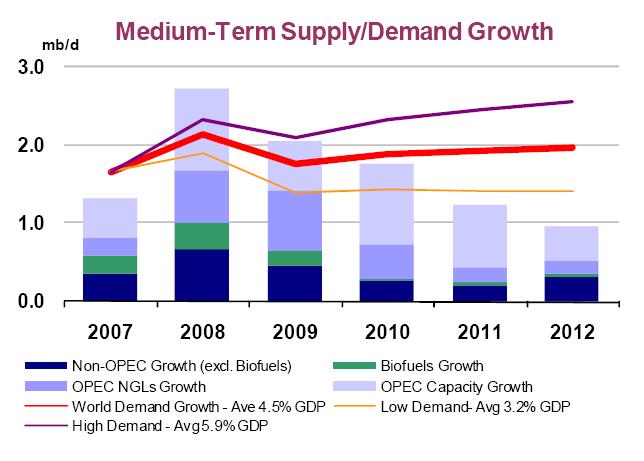 The IEA’s medium term oil market report 2007 showed declining incremental oil production until 2012, with world demand growth above additional capacities, suggesting a gap between supply and demand.
The IEA’s medium term oil market report 2007 showed declining incremental oil production until 2012, with world demand growth above additional capacities, suggesting a gap between supply and demand.
(24) October 2007
Oil & Money Conference at Energy Intelligence, London
In the dying days of the Howard government comes confirmation about OPEC’s overstated reserves in a slide shown in a presentation by Sadad-Al-Husseini
 This time bomb is soon going to explode.
This time bomb is soon going to explode.
It is now only a matter of time until motorists will go on the internet and find out about what is really happening with oil. There is no need to know about peak oil beforehand. Try this in Google and you get it in 0.15 seconds plus 5 seconds scrolling down the page.
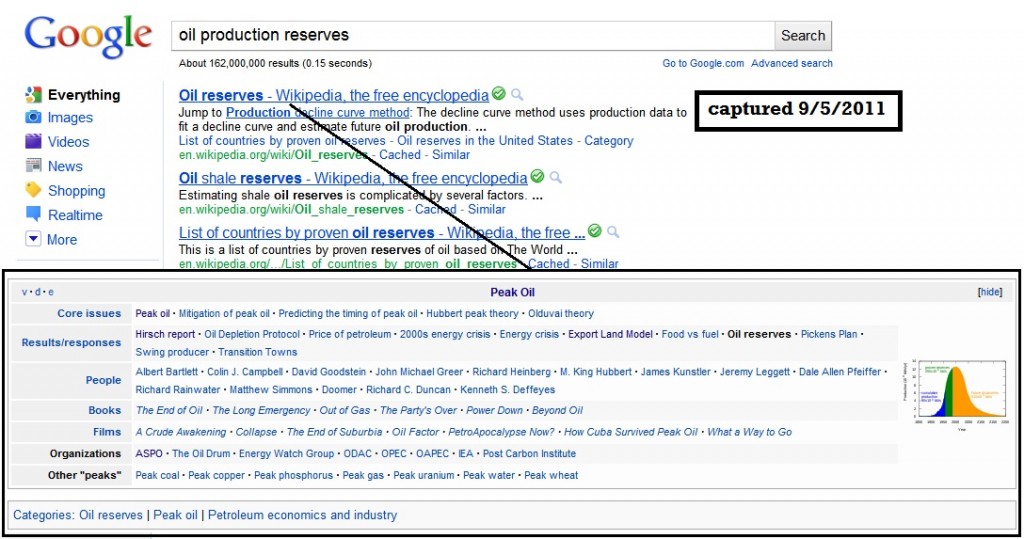 http://en.wikipedia.org/wiki/Oil_reserves
http://en.wikipedia.org/wiki/Oil_reserves
Conclusion: It will be up to inquiries, maybe even courts (example financial collapse of Clem 7 tunnel in Brisbane), to find out exactly why the Howard government did not develop a proper response to peak oil related information. Not that the Rudd-Gillard government was any better and another 4 years were wasted. This is another story. But what matters now is that the public realizes that because of all this time lost many solutions to peak oil – like Very Fast Trains and decade-long metro-tunnel programs in million cities – come too late. We need to immediately abandon business as usual and go into emergency mode. See the menu item “Solutions” on this website.
———–
Amendments included after comments from readers:
11/7/2011 Web link to final Senate report on oil supplies (Feb 2007)

